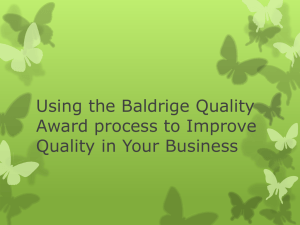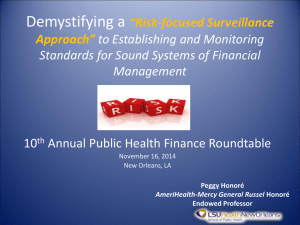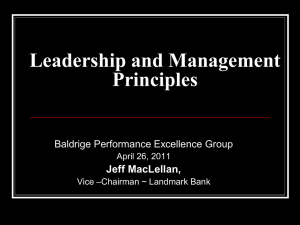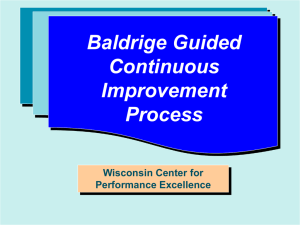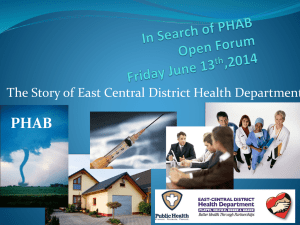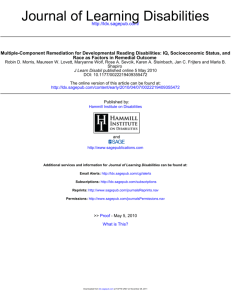1 - National Network of Public Health Institutes
advertisement
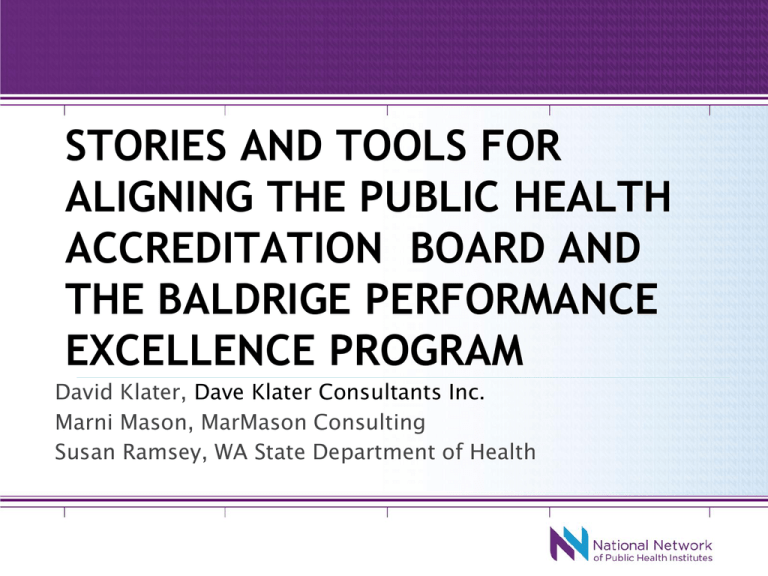
STORIES AND TOOLS FOR ALIGNING THE PUBLIC HEALTH ACCREDITATION BOARD AND THE BALDRIGE PERFORMANCE EXCELLENCE PROGRAM David Klater, Dave Klater Consultants Inc. Marni Mason, MarMason Consulting Susan Ramsey, WA State Department of Health David Klater, Dave Klater Consultants Inc. Marni Mason, MarMason Consulting Susan Ramsey, WA State Department of Health COPPHI Open Forum June 19, 2012 PHAB standards and Baldrige Criteria Overview of Tool WA State Health Department’s Experience Narrative description Appendices Crosswalks ◦ PHAB ◦ Baldrige Baldrige PHAB Four sample applications “The health department must provide a completed performance management selfassessment that reflects the extent to which performance management practices are being used…Self-assessment tools are available through the Baldrige Performance Excellence Program…” PHAB Measure 9.1.2 A Similarities ◦ Self-assessment ◦ Site Visits ◦ Reports that detail areas for improvement Differences ◦ ◦ ◦ ◦ ◦ Required documentation Criteria selection Award status State-based programs Organizational leadership, performance comparisons, and results High level alignment Many expectations and subtleties of the intent of PHAB’s measures Health departments’ clients = entire communities Baldrige Program The Baldrige Criteria Framework Evaluation Factor For Categories 1 to 6 Approach (A) Deployment (D) Leaning (L) Description the methods used to accomplish the process the appropriateness of the methods to the Criteria item requirements and the organization’s operating environment the effectiveness of your use of the methods the degree to which the approach is repeatable and based on reliable data and information (i.e., systematic) your approach is applied in addressing Criteria item requirements relevant and important to your organization your approach is applied consistently your approach is used (executed) by all appropriate work units refining your approach through cycles of evaluation and improvement encouraging breakthrough change to your approach through innovation sharing refinements and innovations with other relevant work units and processes in your organization your approach is aligned with your organizational needs identified in the Organizational Profile and other process items Integration (I) your measures, information, and improvement systems are complementary across processes and work units your plans, processes, results, analyses, learning, and actions are harmonized across processes and work units to support organization-wide goals Evaluation Factor For Category 7 Results Description Levels (Le) your current level of performance Trends (T) the rate of your performance improvements or the sustainability of good performance (i.e., the slope of trend data) Comparisons (C) the breadth (i.e., the extent of deployment) of your performance results your performance relative to appropriate comparisons, such as competitors or organizations similar to yours Integration (I) your performance relative to benchmarks or industry leaders your results measures (often through segmentation) address important customer, product, market, process, and action plan performance requirements identified in your Organizational Profile and in process items your results include valid indicators of future performance your results are harmonized across processes and work units to support organization-wide goals Baldrige Criteria - Possible Points by Category Leadership Strategic planning Customer focus Measurement, analysis, and knowledge management Workforce focus Operations focus Results Total possible 120 points 85 points 85 points 90 points 85 points 85 points 450 points 1000 points The PDCA of Baldrige What? Profile How? Key Factors Criteria Categories 1 to 6 Performance Measures Results Category 7 Evaluate & Improve Lead to Actions Crosswalks Alignment: High, Medium, Low PHAB Description Measure Baldrige Area to Address Statement of Baldrige Criteria and Description of Alignment Domain 1: Conduct and disseminate assessments focused on population health status and public health issues facing the community Standard 1.1 Participate in or Conduct a Collaborative Process Resulting in a Comprehensive Community Health Assessment 1.1.1 Participate in or 3.2a1 Product Offerings: HOW do you identify CUSTOMER and market conduct a requirements for product offerings and services? HOW do you partnership that identify and innovate product offerings to meet the requirements develops a and exceed the expectations of your CUSTOMER groups and comprehensive market SEGMENTS (identified in your Organizational Profile)? community health HOW do you identify and innovate product offerings to enter new assessment of the markets, to attract new CUSTOMERS, and to provide opportunities population for expanding relationships with existing CUSTOMERS, as appropriate? 4.1a3 CUSTOMER Data: HOW do you select and ensure the EFFECTIVE use of VOICE-OF-THE-CUSTOMER data and in-formation (including complaints) to support operational and strategic decision making and INNOVATION? Category 1 - Leadership Baldrige Description Area to Address Alignment: High, Medium, Low or none PHAB Statement of PHAB What health Documentation Measure measure and departments can do to required by Description of address this area for the PHAB that Alignment Baldrige application could be used in the Baldrige application Item 1.1 Senior Leadership: How do your senior leaders lead? 1.1a1 1.1a2 Vision and Values: How do 3.2.1, 5.3.1, senior leaders set your 5.3.2 organization’s vision and values? How do senior leaders deploy your organization’s vision and values through your leadership system, to the workforce, to key suppliers and partners, and to customers and other stakeholders, as appropriate? How do senior leaders’ actions reflect a commitment to the organization’s values? Promoting Legal and Ethical Behavior: How do senior leaders’ actions demonstrate their commitment to legal and ethical behavior? How do they promote an organizational environment that requires it? 3.2.1A Provide Senior Leaders should Communication information ton public implement a systematic of health health mission, roles, communications process department processes…. to to ensure mission and improve the public's communication of vision internally health. 5.3.1A Conduct mission, vision, values to to workforce a strategic planning workforce and and externally process. 5.3.2A Adopt community. to community a strategic plan. PHAB and public. does not require demonstration of senior leadership development. Senior Leaders should implement a process to communicate and role model the importance of legal and ethical behavior by the entire workforce. Related Baldrige Results: 7.4a2 GOVERNANCE: What are your KEY current findings and TRENDS in KEY MEASURES or INDICATORS of GOVERN-ANCE and fiscal accountability, internal and external, as appropriate? 7.4a3 Law and Regulation: What are your RESULTS for KEY MEASURES or INDICATORS of achieving and surpassing regulatory and legal requirements? 7.4a4 7.4a5 Related PH Outcomes and Indicators: Environme ntal PH outcomes or indicators Ethics: What are your RESULTS for KEY MEASURES or INDICATORS of ETHICAL BEHAVIOR and of STAKEHOLDER trust in your organization’s SENIOR LEADERS and GOVERNANCE? What are your RESULTS for KEY MEASURES or INDICATORS of breaches of ETHICAL BEHAVIOR? Society: What are your RESULTS for KEY SocioMEASURES or INDICATORS of your organization’s economic fulfillment of its societal responsibilities and and social your organization’s support of its KEY justice communities? types of outcomes and indicators Results from monitoring PH outcomes or indicators related to compliance with environmental health regulations such as the Food Rule and others Results from monitoring indicators related to Socio-economic and social justice issues such as income levels, high school graduation rates and others Lite Assessment Application 2008 Why Did We Choose WSQA? • Legislatively mandated for all cabinet agencies • Must apply every 3 years • First application in 2008 • Due to budget constraints statewide postponed 2012 application 21 Quality Improvement • Based on Baldrige Performance Excellence which is a nationally recognized performance management framework Why Did We Choose PHAB Accreditation? 22 Quality Improvement • Prior History of Public Health Standards - 1999 • 85 percent of Washington State standards adopted by PHAB • Increase credibility • Assess how well our public health system is working overall • Describe what every public health agency in Washington should be able to do regardless of size or location • Build a stronger and better public health system • Define, measure, and facilitate the improvement of public health protection throughout the state How has WSQA influenced PHAB Accreditation? 23 Quality Improvement • In our case our public health standards influenced our WSQA Application • WSQA used as a management framework • Public Health Standards used as a capacity framework • Many areas overlapped • WSQA Results category forced showing the return on investment Advice for Either WSQA or PHAB Accreditation • • • • • Quality Improvement Manage records Make clear assignments Communication key Identify a team of resources Provide training on Categories or Standards/Measures • Make this a journey and not a one time event 24 What Worked Well? 25 Quality Improvement • Great team • Leadership Support • IT System in place for document collection • Assignment of Categories/Domains • Creating “Read Me” files for each measure • Team of Internal Reviewers • Communications staff as team members Key Lessons Learned Quality Improvement • Plan ahead 9 – 12 month process • Crosswalk from public health standards to Baldrige criteria difficult • Competing priorities • Assign a Champion for each category • Create a team to Champion this work throughout the agency 26 Contact Information Quality Improvement Susan Ramsey, Director Office of Performance and Accountability Washington State Department of Health 360-236-4013 – susan.ramsey@doh.wa.gov 27


